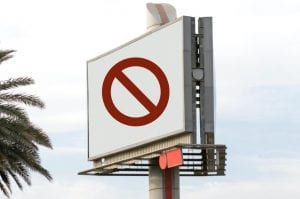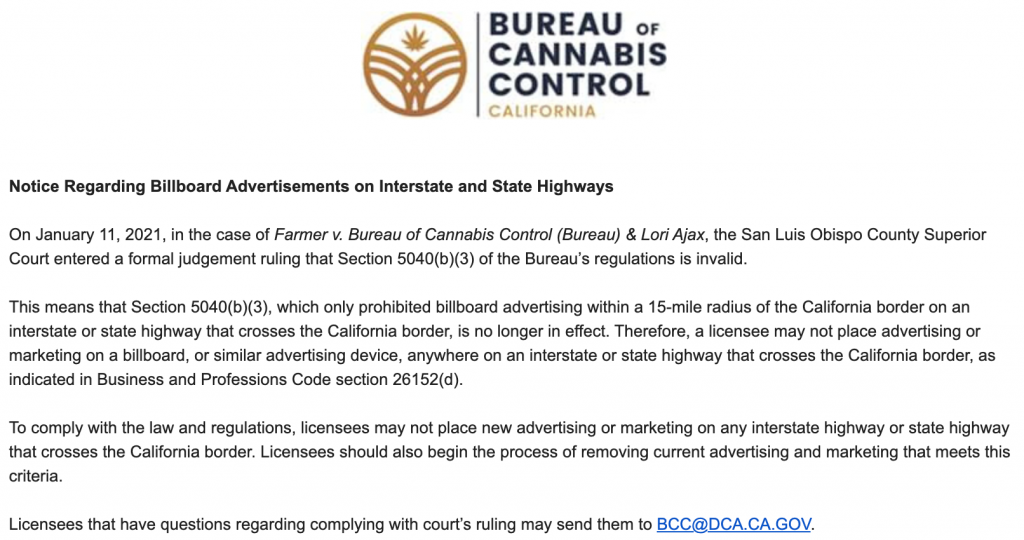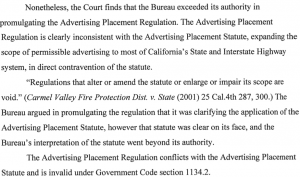Judge Rules BCC Exceeded Authority Regarding Highway Advertisements

By Lauren Mendelsohn
November 25, 2020
(Updated January 12, 2021 & January 21, 2021 – see note at end)
Recently, a judge in San Luis Obispo County ruled that cannabis advertisements can no longer be placed on billboards alongside interstate and state highways that cross the state line. This ruling could have a major impact on cannabis businesses throughout the state, as many of these companies already advertise in this manner (for example along US-101 in the Los Angeles, San Francisco, and Santa Rosa areas, as well as along I-80, I-5, and I-10 in various places throughout the state).
Specifically, the judge said that a regulation (16 C.C.R. §5040(b)(3)) adopted by California’s Bureau of Cannabis Control (“BCC”) in 2019 which purported to allow cannabis advertising on interstate highways within a 15-mile radius of the state border was invalid, as the BCC exceeded its authority when adopting it. The original language of Proposition 64, which is still codified as part of the Medicinal and Adult Use Cannabis Regulation and Safety Act (“MAUCRSA”) in Business & Professions Code §26152(d), says:
A licensee shall not do any of the following:
…
(d) Advertise or market on a billboard or similar advertising device located on an Interstate Highway or on a State Highway which crosses the California border.
This statute seems clear, and the plaintiff in the San Luis Obispo County lawsuit argued that the intent of this rule in Prop. 64, which was approved by the voters in 2016, was to protect children from being exposed to cannabis advertisements on highways. The BCC’s original emergency regulations did not specifically mention highway advertisements, but during the process of adopting their final regulations the BCC made some modifications to Section 5040 (“Advertising Placement”) in an attempt to loosen restrictions on these types of ads. That Section currently reads, in relevant part:
(b) In addition to the requirements for advertising and marketing in subsection (a) of this section, all outdoor signs, including billboards, shall:
…
(3) Not be located within a 15-mile radius of the California border on an Interstate Highway or on a State Highway that crosses the California border.
Thus, according to the judge, the BCC attempted to limit the prohibition in Business & Professions Code Section 26152 (which, again, was approved by the voters as part of Proposition 64) by narrowing the restriction against highway advertisements to those within 15 miles of the state border. While this was a positive development for operators as it provided more opportunities to advertise, the BCC may have exceeded its authority in doing this. Such an action seems contrary to the Administrative Procedure Act’s “Necessity” and “Consistency” standards (Gov. Code § 11342.2), which we previously discussed here.
Gov. Code §11342.2. Whenever by the express or implied terms of any statute a state agency has authority to adopt regulations to implement, interpret, make specific or otherwise carry out the provisions of the statute, no regulation adopted is valid or effective unless consistent and not in conflict with the statute and reasonably necessary to effectuate the purpose of the statute.
The judge in the San Luis Obispo case found that Section 5040(b)(3) of the BCC’s regulations (the “Advertising Placement Regulation”) is invalid:
Ruling, pages 18-19.
You can read the full ruling here: Ruling on BCC Advertising Placement Regulation
According to news reports, the BCC has not stated whether they will appeal if the ruling holds (which is not yet a final judgement at this stage), or when existing guidance regarding advertisements might be updated in response to this. The timeline for potential removal of noncompliant billboards is also unclear at this time, though in the coming days and weeks more information will surely come to light. That said, we anticipate that there will be further debate surrounding this restriction, for example vis-à-vis an argument that it constitutes an unconstitutional restriction of commercial speech.
Given the fact that MAUCRSA does not contain a 15-miles-from-the-border exemption, cannabis companies who relied on the BCC’s regulations and chose to advertise on highways that cross the state line provided they were outside of this radius may want to reconsider their strategy, and to follow this story as it develops.
UPDATE 1/12/21: A final judgment has been reached in this case. The judge has ordered the BCC to get rid of 16 CCR §5040(b)(3) and to notify licensees that they cannot advertise along Interstate highways or highways that cross the state line, regardless of how far the advertisement is from the border (see Judgement for 19CV-0597).
UPDATE 1/21/21: The BCC, CDFA and CDPH sent out notices to all licensees and stakeholders today about the deletion of 16 CCR §5040(b)(3), and reminding them that pursuant to Business & Professions Code §26152(d) they may not advertise along any Interstate highways or other highways that cross the state line. The BCC’s notice is shown below.

This information is provided as a public educational service and is not intended as legal advice. For more information about cannabis laws, regulations, and licensing in California, please contact the Law Offices of Omar Figueroa at 707-829-0215 or info@omarfigueroa.com to schedule a confidential legal consultation.

